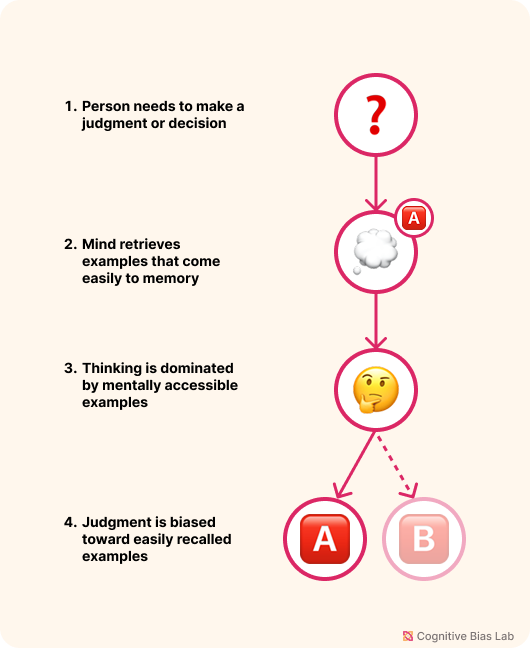Availability Heuristic
Your progress on this bias test won't be saved after you close your browser.
Understanding Availability Heuristic
Availability Heuristic
We often overestimate the importance of vivid or recent events, letting easily recalled information outweigh objective data in our decisions.
What is the Availability Heuristic?
The availability heuristic is a mental shortcut where we judge how likely something is based on how easily we can recall examples of it. If an event is dramatic, emotional, or frequently reported, it feels more common or important than it actually is.
How It Works
When asked to assess how probable something is, we often don’t calculate based on facts or statistics. Instead, we reach for whatever comes to mind first. The easier it is to remember an example, the more likely we are to believe it reflects reality.
For instance, after watching news stories about violent crimes, people might believe crime rates are rising, even if long-term data shows a decline. Vivid stories stick in memory, while slow trends and quiet facts fade into the background.
Psychological Mechanism
This bias taps into how our memory and emotions are wired. Events that are recent, emotionally intense, or visually striking tend to be stored more accessibly in our minds. When faced with a decision, we confuse what is easy to remember with what is likely to happen.
Because of this, rare but sensational events—like plane crashes or shark attacks—get overestimated, while common but less memorable dangers—like heart disease or texting while driving—are often overlooked.
Why It Matters
The availability heuristic can:
- Distort our sense of risk and safety
- Influence how we vote, travel, spend, and parent
- Shape public reactions to crises or tragedies
- Lead to poor decisions in health, finance, and policy
Being aware of this bias helps us pause and ask: Is this really common, or just easy to recall? Only then can we start making choices that reflect actual probabilities, not just memorable moments.

Visual representation of Availability Heuristic (click to enlarge)
Examples of Availability Heuristic
Here are some real-world examples that demonstrate how this bias affects our thinking:
Psychological Study Simulation
The Availability Heuristic
Experience how our minds judge frequency based on how easily examples come to mind, recreating a classic experiment from Tversky and Kahneman's 1973 study.
Media Influence on Risk Perception
After extensive news coverage of a shark attack, beach attendance drops dramatically, even though the statistical risk of shark attacks remains extremely low (about 1 in 11.5 million). Meanwhile, people continue driving to the beach without concern, despite the much higher risk of a car accident (1 in 107). This demonstrates how easily recalled events can disproportionately influence our perception of risks.
Professional Decision Biases
A doctor who recently diagnosed a rare disease becomes temporarily more likely to consider that disease in patients with similar symptoms. This happens because the recent case is fresh in memory and comes to mind quickly during diagnosis, potentially leading to overdiagnosis of the rare condition despite its statistical unlikelihood.
Investment Decisions
Investors often gravitate toward stocks from companies they're familiar with or that receive significant media attention. This familiarity makes information about these companies more readily available in memory, potentially leading to portfolios with less diversity and higher risk than investors realize. The availability of information creates an illusion of safety that may not be supported by financial data.
How to Overcome Availability Heuristic
Here are strategies to help you recognize and overcome this bias:
Consult Objective Data
Before making important decisions, actively seek out statistical information and comprehensive data rather than relying on the examples that come to mind first. This helps counter the bias toward recent or memorable events.
Consider the Opposite
Deliberately challenge your initial judgments by asking, 'What if the opposite were true?' This technique helps expose when your thinking is overly influenced by available information rather than balanced evidence.
Use Decision-Making Frameworks
Implement structured approaches like checklists, probability assessments, or decision matrices that force consideration of multiple factors beyond the most mentally available examples.
Test Your Understanding
Challenge yourself with these questions to see how well you understand this cognitive bias:
After media coverage of teenage vaping hospitalizations, quit-resource requests spike 40% but return to normal six months later despite continued education. What does this pattern suggest?
Academic References
- Tversky, A., & Kahneman, D. (1974). Judgment under Uncertainty: Heuristics and Biases. Science, 185(4157), 1124–1131.
- McRae, C., & Dubé, L. (2024). Availability bias and heterogeneity in saliency, recency, and frequency of promotions for plant-based foods: a naturalistic observation. Frontiers in Behavioral Economics, 3.
- Berthet, V. (2022). The Impact of Cognitive Biases on Professionals’ Decision-Making: A review of four occupational areas. Frontiers in Psychology, 12.